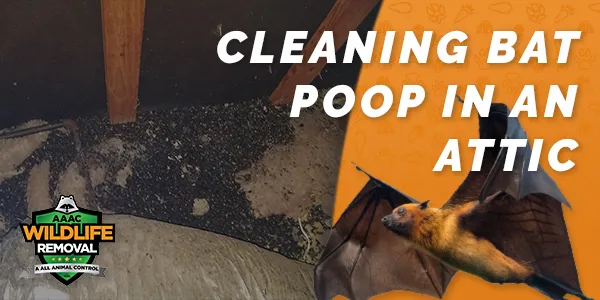After a successful bat abatement project, you may be left with hazardous guano on the attic floor. Cleaning bat poop can be a nasty and smelly job. The waste material not only emits a nasty odor but also poses significant health risks to those who come into contact with it. Fungus spores from disturbed guano are easily dispersed in the air and when inhaled can lead to a severe respiratory illness called Histoplasmosis. Bat diseases are no joke! Nevertheless, guano clean-up should be done as it is essential to the safety of your home!
What do the droppings look like?
Bat guano looks almost like rodent droppings, but typically larger, about a quarter of an inch in length on average. They can either be black or brown in color and cylindrical in shape. These guano sparkles when crumbled, this is because of the insect exoskeletons present in the dung.
Before starting clean up
The main concern with guano is the fungal spores that can easily go airborne once the dung is disturbed. To prevent this, ensure that the area is contained and sealed.
- Shut off the heating system and forced air ventilation system.
- Seal the intake mesh as well as the exhaust vents to prevent dust particles and spores from entering the house.
- Seal all openings in contaminated area with heavy duty duct tape and polyethylene sheeting.
How to clean bat guano in the attic
Cleaning bat guano in an attic is a messy job, but it’s necessary to avoid health risks associated with the feces such as Histoplasmosis. Below are eight steps that cover all aspects of cleaning guano in attics:
- Wear personal protective equipment
- Double-check that all bats are excluded
- Pre-treat droppings
- Use vacuum cleaner to remove scattered poop
- Use hazardous waste bags
- Replace soiled insulation
- Scrub surfaces with an enzyme-based cleaner
- Fog the contaminated area
Cleaning bat droppings
Here are the steps to follow to successfully clean bat feces from an attic:
Wear protective clothing
In guano removal, it is important to start by wearing personal protective equipment. Thick gloves, surgical masks, and eye protection are vital because bat feces is hazardous and contains bacteria and parasites that can easily make you ill.
Double check all bats are removed
It is important to make sure that all bats are gone before you start your attic cleanup. Inspecting the entire attic thoroughly will prevent accidental bat contact during guano removal. Make sure that there are no baby bats left behind for mothers who might still be nursing as these young ones cannot yet fly away themselves! These bats will starve and die there in your attic and leave you with another problem. Make sure to wait until bat maternity season has concluded before making your move. Since bats are protected at the federal and state level, it’s a good idea to exercise patience.
Pre-treat bat droppings
Dampen the droppings first with a spray bottle to prevent them from crumbling and fungal spores from dispersing into the air. This lessens your chances of inhaling fungal spores.
Use vacuum to remove droppings in attic
Vacuuming is an effective method for removing scattered feces from floorboards, insulation, and other areas that are hard to reach. Be sure that you are using HEPA filtered industrial vacuums so as not to stir up spores while vacuuming the feces out of your attic.

Use hazardous waste bags
In order to dispose of all bat guano properly, it needs to go into a hazardous trash bag before disposal outside your home (in accordance with local laws). Seal up all contaminated clothing as well after use so nothing gets out by accident while transporting them.
Remove soiled insulation
If bats were living on the rafters inside a home, they will leave behind droppings or urine wherever they roosted such as on insulation. These must be removed and replaced to avoid further bacterial or mold growth.
Scrub contaminated surfaces with water and enzyme-based cleaner
Bat poo is toxic and so must be scrubbed away from surfaces using an enzyme-based cleaner or enzymatic cleaners sold at your local hardware store. This will help to eliminate the smell of guano and break down organic material as well as neutralize any harmful pathogens on exposed areas.
Fog the area to reach every nook and cranny
To get bacteria and mold off of surfaces such as hard-to-reach areas like corners or ledges, you can use a fogger to reach every nook and cranny. Foggers are also effective for reaching behind beams and within wall cavities where dung particles might have been missed.

Problems and dangers of bat feces in attic
Leaving bat waste in the attic after bat removal is a big mistake. The feces contain bacteria and parasites that are harmful if they come into contact with people and also release spores that you or your family and pets can inhale. Here are problems and dangers caused by guano build up in an attic (or any place that bats might live):
- creates nurturing environment for histoplasmosis causing fungi
- encourages bacteria and mold growth
- creates a horrible smell
- attracts other pests due to odor
- causes stains in the ceiling
- rots any wood in your attic
- causes ceiling cave ins
Histoplasmosis
Histoplasmosis is a massive health risk associated with bat dung. It’s a respiratory illness caused by inhaling the fungus spores Histoplasma capsulatum from the guano. It has flu-like symptoms that include fever, headache, fatigue, dry cough, and chest pain. It can be fatal especially for those with weakened immune systems or lung diseases such as asthma.

Bacterial and mold growth
Bat feces can also encourage bacterial and mold growth which can lead to severe health issues. Mold is a fungus that can produce mycotoxins, which are toxic substances that cause severe allergic reactions in humans and have been linked with asthma as well as other serious illnesses such as cancer.
The bacteria from bat guano is not dangerous to bats but will make people sick with stuff things like salmonella, e Coli, and typhoid fever if they come into contact with the feces. There are also some parasites that live in bat poo such as roundworms and other intestinal worms that could cause serious health issues for those who might accidentally ingest them.

Foul odor
Bat dung creates a strong, foul odor that is likely to spread into your home. This smell seeps into your walls and ceilings, making it difficult to get rid of.
Attracts other animals and insects
The pheromones in bat waste can also attract other bats or other animals like snakes. It also attracts pesky insects such as flies or cockroaches and increases the risk of disease transmission or creating a secondary infestation.
Causes staining
Bat poop in an attic can also create unsightly stains on ceilings over time. Rotting droppings, as well as any other organic material that accumulates because of an infestation, will cause stains to form around the edges of your ceilings from seepage or mold growth. These need to be cleaned right away before they have a chance to set so you don’t end up with ugly brown patches everywhere!
Rotting wood
Bat fecal matter contains high levels of uric acid which will rot untreated wood over time. If left unaddressed for too long, the dung will rot wooden surfaces like rafters, roof beams and may even reach floorboards below and cause structural damage by weakening them over time
Ceiling cave ins
Bats eat a lot of insects (up to their weight in a night!) and they poop a lot too! And sometimes the guano can pile up as high as a couple of feet deep. This problem is compounded by bat droppings that rot and produce methane gas which is a powerful agent of decay. The guano can also absorb the moisture from wooden surfaces, drywall, or insulation underneath it causing these materials to soften and break down over time. This will eventually lead to cave-ins in ceilings where feces pile up!
Bat guano cleanup specialists
AAAC Wildlife Removal offers bat removal services as well as guano cleanup and attic repair services. After we remove your bat problem, we’ll ensure guaranteed sanitization and decontamination of your attic. Our professional wildlife control experts are available to remove toxic droppings from your attic to keep you safe at all times! Call AAAC Wildlife Removal today! We can help you with the problem no matter what those bats do to your home or business.
Damage repair and attic restoration
Aside from bat removal and guano clean-up, we also offer professional attic restoration services at AAAC Wildlife Removal. Our technicians are experienced in restoring attics from bat infestation so you don’t have to worry about any damages caused by bats. With our full-service approach, we’ll also ensure complete sanitization and deodorizing of your home while also providing structural repairs if needed after completing an effective bat removal process.

Conclusion
Cleaning bat feces in an attic can be hazardous, complex, and time-consuming. A typical homeowner should not attempt it without the proper protection and equipment required. Bat dung creates a health hazard for humans by spreading bacteria and mold spores that are toxic even in small quantities. It also creates stains on ceilings over time and can cause structural integrity issues. Removing bat waste in the attic after a successful removal is essential and should be addressed immediately before it can create any major problems.
FAQs
Can I vacuum the bat guano?
You can, however, you can’t simply use your regular home vacuum cleaner. The spores in bat droppings are too fine and will disperse all over your home, so a special one with a HEPA filter is required for cleanup in the attic.
Can I clean bat guano in attic myself?
It can be done, however, we don’t advise you to try guano removal yourself, as it is time-consuming and dangerous for the uninitiated! It requires specialized equipment and a thorough understanding of bat biology. We recommend hiring professional bat control experts to clean feces in an attic, as it will save you time and money!
Originally published on https://aaacwildliferemoval.com/blog/bats/cleaning-bat-poop-in-the-attic














